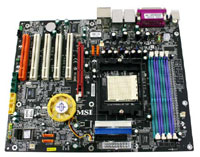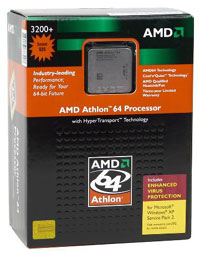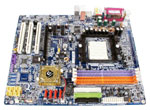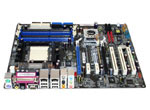Buyer's Guide - Mid-Range, January 2005
by Jarred Walton on January 21, 2005 11:09 AM EST- Posted in
- Guides
AMD Motherboard and CPU Recommendations
We've already covered the basic dilemma with the AMD platform right now: to PCIe or not to PCIe, that is the question. You hopefully know yourself well enough to have made a decision on whether you want to be an early adopter or if you want to trail behind the bleeding edge and take a conservative approach. Our recommendations, incidentally, are made in light of what is actually available right now. We look at several vendor sites as well as our own RealTime Pricing Engine to find out what is currently in stock. That means there are exactly three PCIe boards from which to choose, and two of them are really in the high-end performance market (the SLI boards).
 |
 |
| Click images to enlarge. | |
AMD Platform Recommendation
Motherboard: MSI K8N Neo2 Platinum (NF3 250 Ultra)Price: $139 Shipped
Processor: Athlon 64 3200+ 90nm (Retail)
Price: $215 Shipped
On the conservative approach, we continue to stick with the AGP platform and the nForce3 250 Ultra chipset. The MSI K8N Neo2 Platinum [RTPE: MSI K8N Neo2 Platinum] has worked very well in our testing, and we have several systems using it that are running without any problems. Tweaking and overclocking options are very good if it's something that you're interested in, and you get known reliability and performance with a low chance of any unforeseen bugs in your system. If living on the bleeding edge and potentially troubleshooting your new PC on a regular basis is not your idea of a good time, this is still the most sensible platform. Realistically, this will probably be the last time that we actually recommend this platform, as the new nForce4 motherboards - not to mention alternatives using the ATI Express 200 chipsets and perhaps even some VIA PCIe solutions - should reach the point where we can give them a full recommendation by the time we next run our Mid-Range Guide.
For the processor, we opt for the 90nm Athlon 64 3200+ part [RTPE: ADA3200DIK4B]. It offers plenty of power with a reasonable price. Overclockers will also appreciate the added clockspeed headroom and reduced heat of the 90nm parts, but that's a topic for another Guide. A 3500+ would be nice, but the 90nm parts are too expensive while the 130nm 3500+ has a higher power draw. Our tests showed that the power draw of the 90nm parts is significantly lower than the 130nm parts. So, if you're the one actually paying the electricity bills, the 90nm parts will easily save you money over time, relative to the 130nm parts - particularly if you leave your PC running 24/7.
 |
 |
 |
| Click images to enlarge. | ||
AMD Platform Alternative
Motherboard: Gigabyte GA-K8NF-9 (NF4 4X)Price: $146 Shipped
Motherboard: ASUS A8N SLI Deluxe (NF4 SLI)
Price: $197 Shipped
Processor: Athlon 64 3500+ 90nm (Retail)
Price: $324 Shipped
For those who like to live on the edge, PCI Express boards are finally starting to appear at retail. Finding them in stock, unfortunately, can be difficult, and this affects our recommendation. You'll have to wait for a full review, but our "mid-range" suggestion right now is to pick up the Gigabyte GA-K8NF-9. Newegg has listed the Chaintech VNF4/Ultra [RTPE: Chaintech nForce4 Ultra VNF4] for a couple weeks now, but either they're disappearing so fast that they're almost never in stock, or they may not really be available yet. The Chaintech looks to be the potentially better performer, as it includes the Ultra version of the nForce4 chipset instead of the cheaper 4X version. The difference, if you recall, is that the Ultra has an unlocked HyperTransport multiplier that should offer more in the way of overclocking, while the 4X is supposed to be locked at a 4X HyperTransport multiplier (800 MHz) - at least, it's not validated to run at anything other than 4X. If you're not concerned with official validation, the Gigabyte GA-K8NF-9 [RTPE: Gigabyte nForce4 GA-K8NF-9] is readily available from several sources, and it includes some additional features like IEEE1394b.
If you're really serious about shifting to PCI Express boards right now, a better pick would probably be the ASUS A8N SLI Deluxe [RTPE: ASUS nForce4 A8N-SLI Deluxe], which is available for about $200 now from several locations. Gigabyte and MSI also offer SLI boards, but they're less available and even more expensive than the ASUS. We've talked a lot about the benefits of SLI vs. non-SLI, but let's just say that it's the only option that makes a lot of sense to us at this moment in time. If you really want to make the shift to PCI Express, you might as well get an SLI motherboard at the same time. It's a high-end option, of course, but so are all PCIe graphics cards above the 6600GT.
For the processor on our alternative platform, we've upgraded to the Athlon 64 3500+ processor [RTPE: ADA3500DIK4B]. Spending more for the 3800+ will take us well out of the mid-range price segment, as the 3800+ costs nearly twice as much as the 3500+ - even the 3500+ is rather expensive. We use the 90nm 3500+ as opposed to the 130nm version (which is cheaper at present). With the potential SLI video cards sucking down a lot of power, it can't hurt to cut the processor's power consumption.










46 Comments
View All Comments
JarredWalton - Friday, January 21, 2005 - link
Rand - That doesn't surprise me too much, given our recent article showing that the NF4 Ultra and NF4 SLI are the same chip with a tweaked package. I would guess there's a reasonable chance the NF4 4X is the same as well, with other modifications to the package. As far as I know, what I put about their difference is the "official" NVIDIA stance. If the 4X is just the "validated" version... well, not a big deal, really. I'll modify the text a bit to reflect this.KristopherKubicki - Friday, January 21, 2005 - link
N3cr0: The nForce4 board you mentioned is not shipping yet.Kristopher
Jep4444 - Friday, January 21, 2005 - link
I think the Asus A8V Deluxe would of been a better motherboard recomendation than the MSI K8N Neo2 Platinum. The Asus board is pretty much the best 939 AGP board out and it costs less than the MSI aswell.Avalon - Friday, January 21, 2005 - link
'Samsung calls the 997DF a "perfectly visually flat" tube. What they really mean is that the surface of the glass is perfectly flat, but the inside of the glass is very slightly curved. Most people will never notice it, but we feel that in the interest of full disclosure, it should be mentioned'Yes. Thank you for pointing that out, Jared. I purchased this monitor about a month ago, and noticed it right upon powering it up. No matter how much you adjust the geometry, there is always a slight curve. I was so angry at one point I was either going to hit it with a bat or return it. Now I've just learned to deal with it, and I'm no longer really bothered by it.
Rand - Friday, January 21, 2005 - link
Slight addendum to my above post-I just tried nVidia's hardware firewall.. it's working fine.Apparently that also runs on the basic nForce4.
Rand - Friday, January 21, 2005 - link
Slight addendum to my above post-I just tried nVidia's hardware firewall.. it's working fine.Apparently that also runs on the basic nForce4.
Rand - Friday, January 21, 2005 - link
"The difference, if you recall, is that the Ultra has an unlocked HyperTransport multiplier and will generally offer more in the way of overclocking, while the 4X is locked at a 4X HyperTransport multiplier (800 MHz)."I believe that's since been proven false.
There are a couple threads in the Motherboards forum about overclocking on said board, and I haven't seen anyone comment on any difficulties adjusting the HTT.
My own board is running at 300x3 HTT (900MHz HTT) right now. (Adjustable from 2-5X), though it did need +0.2V to the chipset to run stable at 1000HTT.
The differences right now between the NF4 and NF4 Ultra would appear to be 3Gb/s SATA vs. 1.5Gb/s SATA, and official support for 1000HTT vs 800HTT.
As well as not supporting nVidia's firewall.
geogecko - Friday, January 21, 2005 - link
Where are all the nForce4 Ultra (non-SLI) boards? Really looking forward to ASUS A8N-E Premium, but no news, except that some have said this board will never exist?!Gage8 - Friday, January 21, 2005 - link
I don't know, this guide just confirmed for me that now is not the time to buy if you want stability and upgradability (new word?).Nforce2 taught me not to buy revision 1.x...so lesson learned, bring on Nforce4 revision 2.x.
N3cr0 - Friday, January 21, 2005 - link
Just curious why the MSI K8N Neo4 Platinum/SLI wasn't put in as an SLI board for the AMD choices. It seems to be lower price then the Asus board. I'm going to get one of the two boards and can't really figure out what the differences are aside from some networking items. (That and the HyperTransport which I dont get at all)